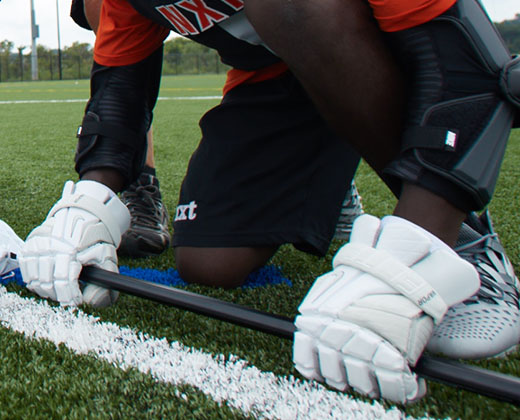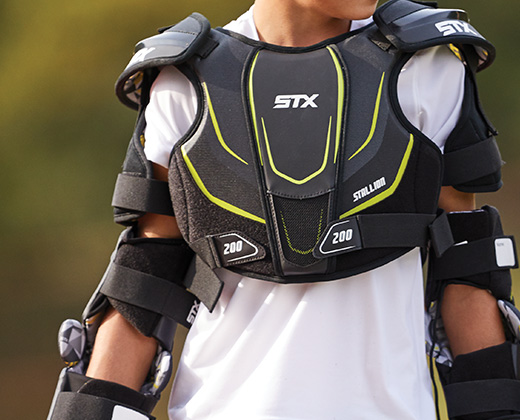How to Choose a Mens Lacrosse Helmet
Stand tall with a protective, well-fitted lacrosse helmet next time you take the field.
Body checks. Stick checks. Battling for ground balls. Setting a screen to get a teammate open.
Men’s lacrosse is a full-contact sport. The raw physicality is what even draws some players to the sport.
With this level of competition, it is important to make sure you have the right protection when you step out on the field. And the most important piece of equipment might be your helmet.
“There are three main impacts in lacrosse,” DICK’S Sporting Goods Associate and former lacrosse player Tyler Ranft said. “You are going to get hit with a check. You could get hit with a ball, and they are not soft and can be shot at over 100 MPH.
“Also, you play with metal sticks.”
A lacrosse helmet should offer a combination of characteristics: a lightweight fit with clear vision and strong protection. But, where do you start? There are several options and designs you will need to consider to find the helmet that best fits you.
SAFETY FIRST
Lacrosse helmets are designed with several components to help keep you safe:
- Shell – This is the overall hard outer plastic body of the helmet. While it is designed to protect against impact, the shell is also made to be lightweight so not to hinder movement. Many shells will have ventilation holes in them to help keep you cool as well.
- Liner System – The shell is lined with a layer of foam-like material designed to help absorb impact.
- Facemask – The facemask fits across the front of the helmet and is designed to protect your face from misguided sticks or lacrosse balls. Typically made of lightweight metal, facemasks are designed so that they don’t hinder your vision.
- Chin Bar – This is the lower part of the helmet, which is designed to protect the jaw and lower face.
- Chinstrap – Located inside the helmet, the chinstrap is designed to help with proper fit. This can be replaced to better fit a player with a different model.
Lacrosse helmets come with a four-point buckling system that helps customize the fit for each player.
“Most of them are built similar to a football helmet,” Ranft said. “Overall, there is full-face protection thanks to the facemask. You are getting a combination of face and impact protection.”
Goalies wear the same helmet as attackers, defensemen and midfielders, but will need to add a throat guard. This is a piece of plastic that attaches to the bottom of the helmet, which is designed to help protect the neck.
Any helmet you wear should be approved by the National Operating Committee on Standards for Athletic Equipment (NOCSAE), the group responsible for setting the safety standards all helmets must meet.
THE RIGHT FIT
A properly fitted helmet is essential.
Most lacrosse helmets come in adult or youth sizes and are designed as one-size-fits-all that can be adjusted for a proper fit. Some models do come in different sizes based on head circumference in inches. To find your circumference, measure around the head about one inch above your eyebrows. Check the measurement against a size chart on a helmet’s packaging to find the recommended size.
A lacrosse helmet should fit snug on your head. The padding of the helmet should give a firm, even pressure. It should have a tight fit, but not to the point that it causes discomfort.
To make sure your helmet fits properly, test it by moving it back and forth on your head. As you do this, the skin of your forehead should move with it. A rule of thumb for proper fit is you want to be able to see out of the top opening of the facemask and have the entire field of play in view.
Your chin strap should be tightened so there is no slack. All the buckles must be fastened in order to play. A helmet that is too loose can tilt backward or forward, causing your view to become obstructed.
When sizing a helmet, take your hair into account. If you have a thick head of hair during the offseason but cut it short before the season, you will need to adjust your headgear to fit accordingly.
MAINTENANCE
Inspect your helmet before each use. If it ever shows signs of compromise – whether it’s a crack, dent, scratches or a bent facemask – you should replace it.
It is recommended that players prepare their helmet for each season by replacing screws, nuts and the faceguard if it’s bent.
DOING IT IN STYLE
One thing most lacrosse players will look for when buying a lacrosse helmet is a way to express themselves and standout. Helmets do come in a variety of models and hues so players can choose from them to help add personality to their gear.
“The main thing kids go for when looking for their helmet is the look of it,” Ranft said. “Once they have the protection, they are going for the looks.”
You can purchase a variety of decals to put on your helmet, too. Teams can get customized decals or use helmets that feature finishes and colors to match their uniform.
Now that you know what to look for in a helmet and proper fit, strap it on and get on the field. Having the proper equipment will allow you to focus on scoring a game-winning goal or making that big save.








